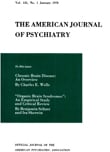Abstract
Previous reports in the literature have crystallized quite well the results effected by frontal lobotomy in the treatment of the major psychoses. Our present investigation, which deals particularly with dementia præcox, gives further support to previous conclusions. Apparently one can anticipate that some 50% to 60% of appropriately selected patients will exhibit significant improvement following frontal lobotomy, with approximately equal division between levels of moderate improvement and of marked improvement. There appear to be relatively few relapses with the passage of time—at least within a 2-year period—and, statistically, these relapses are compensated by other cases that exhibit their optimal improvement after a year or more of postoperative interlude. In general, results are somewhat better in affective disorders and other nonschizophrenic conditions than in dementia præcox. Among the latter, best results are observed in the mixed and paranoid subgroups. Symptoms related to tension and depressive states, emotional aggressiveness, and hyperkinetic behavioristic features are most amenable to lobotomy. This lends support to the implication emphasized by other investigators that the clinical results of psychosurgery are attributable to its influence on emotionally charged psychic phenomena, presumably through interruption of appropriate thalamic radiations. Our discharge rate of some 37% agrees closely with the statistics of other large series of cases. The most frequent significant complication, convulsive seizures, appears to occur in some 10% to 15% of patients. It is generally accepted that this is not a burdensome complication; it is readily controlled by anticonvulsant therapy. Operative mortality appears to range around 2% to 3%.
The problem of controls has been of particular interest to us in this study. It was decided that the most satisfactory controls would be patients who, like the operative group, had been selected for lobotomy according to currently recognized clinical criteria, but on whom operation could not be performed because of refusal of permission by the family. The 2 groups were well matched from the standpoint of various factors, especially in the pertinent features of diagnostic grouping and symptomatology. Although the mean duration of hospitalization was somewhat lengthier in the control group, the difference was not sufficiently pronounced to exert a significant effect on the final results. The great majority of both groups had been hospitalized longer than 2 years, a temporal point that appears to be critical from the standpoint of recovery spontaneously or by the aid of therapeutic measures other than lobotomy.
In contrast to the operative group, there was practically no change in the status of the control group at the termination of the 2-year observation period. Only 3% exhibited significant improvement—none at a level superior to moderate improvement. No significant long-term improvement was achieved in this chronically ill control group by the use of shock therapies. Only 2% were able to leave the hospital, and one of these patients required rehospitalization within a relatively short time. It seems evident, particularly with respect to dementia præcox, that the course of the illness will be well crystallized before the end of the second year of hospitalization. Improvement, either by spontaneous means or by the use of shock therapies, is rare after this point, and it would seem fruitless to delay psychosurgery in appropriate cases much beyond this time. Comparative results in our 2 groups lead to the inevitable conclusion that lobotomy exerts a beneficial effect that is not achieved by other means in cases of chronic mental illness.

